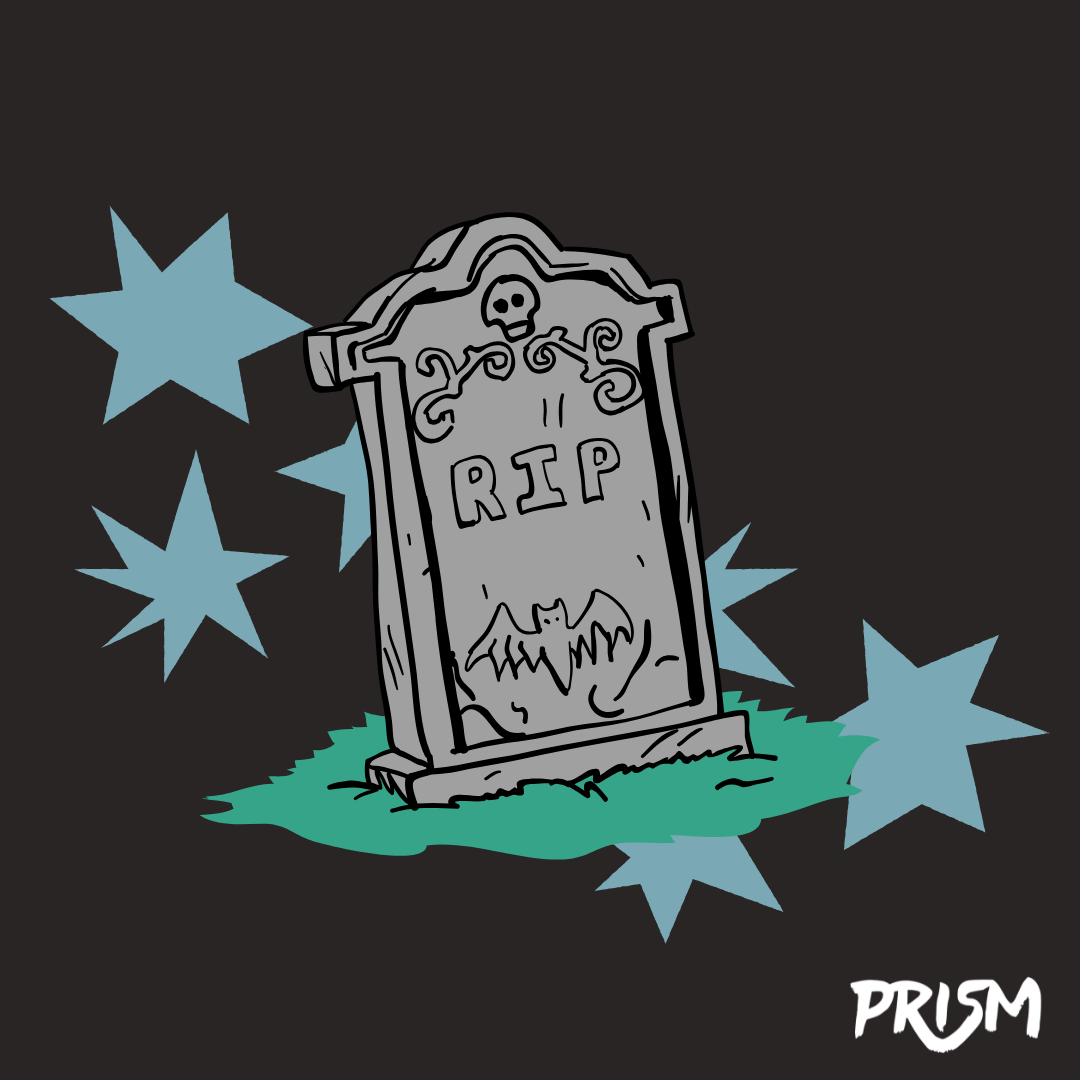Warning: The following includes spoilers for all three currently released books in “The Locked Tomb” series
“To love and to be loved is to change” — a familiar sentiment, but one that begs the question: At what cost? What is sacrificed in the transformation that love causes? And, how do we move forward in the aftermath of that change?
In her book series “The Locked Tomb,” Tamsyn Muir explores these questions with the ruthlessly violent precision of a scalpel. Bloody, wickedly smart, delightfully unexpected and oh-so-queer, “The Locked Tomb” (colloquially referred to as TLT) is a series that is nigh-impossible to describe — though I will give my best attempt — yet remains the most masterful work I’ve ever had the pleasure of reading. If you have not read it yourself, and you find yourself interested at any point during this blog post, I beg you: Stop reading this and start reading “Gideon the Ninth.” You will not regret it.
Returning to the questions at hand: Love and sacrifice are so deeply entwined in the series, from the relationships between characters to the worldbuilding itself, that they almost cease to be two separate things. They are the foundation on which the primary dynamic within the series rests: that of the necromancer and their cavalier. Each of the Nine Houses that make up society in TLT — each on one of the planets in our solar system — have a number of necromancers. A necromancer is a magic user who utilizes “thanergy” or death energy, to do a multitude of acts — creating bone constructs, contacting ghosts, even healing — while a cavalier is their sword-wielding protector. This relationship is inherently made up of love and sacrifice; the cavalier provides endless support and loyalty to their necromancer (love), even at the cost of their own life (sacrifice). But it is far closer to a partnership than the imbalance of a master/servant relationship. The series portrays all sorts of bonds between necromancer and cavalier: love that is romantic, familial, platonic and even transcends beyond easily definable categories.
If the necromancer/cavalier relationship represents love and the willingness to sacrifice, then the process of becoming a “lyctor” is the consequence of change. A “lyctor” in TLT is an immensely powerful and immortal necromancer, of which there are only a handful in existence. Throughout the first book, necromancer and cavalier duos work together to discover how a necromancer becomes a lyctor, intent on carrying out the process for the betterment of their Houses. However, when the process is revealed at the end of the first book, that goal comes to a screeching halt: In order to ascend, the necromancer must kill and consume their cavalier, body and soul. The moment is a repulsive realization that puts a spotlight on the brutal reality of the TLT universe — the brutal reality of how far one is willing to go for what they love. By sacrificing and quite literally consuming someone to become a part of yourself, you are changed into something completely different, practically alien. The end of the first book takes the newly Christened lyctors away from their homes, and their new limitless power and near impossibility to kill renders them unrecognizable, inhuman.
But this change goes beyond new abilities. The short story included at the end of the third book follows the character Palamedes as he discovers what he refers to as the “permeability of the soul” — that is, a cavalier’s soul does not simply act as a constant thanergy battery once consumed by a necromancer, but permanently changes the necromancer’s soul too. Ianthe, the lyctor Palamedes interrogates to make this observation, realizes with dawning horror that she has memories and habits that she never had before — that her cavalier had. Which begs the question — of the lyctors who are 10,000 years old, how much of them is really them, and how much is their long-dead cavaliers? When you love someone, where do they stop and you begin?
While the lyctor process is a clear example of sacrifice in the name of love, TLT proves that not all sacrifice is created equal. The three types of sacrifice I would like to pay special attention to are sacrificing the self, sacrificing others and mutual sacrifice — each with their own costs and their own consequences.
The first, and the one that repeatedly haunts the series narrative, is sacrifice of the self. At the end of the first book, shortly after the gruesome reality of lyctorhood is revealed, the main characters — Gideon, a cavalier, and Harrow, her necromancer — are forced into an impossible situation. Faced with the wrath of a thousands-of-years-old lyctor, it seems there is no escape from death — unless, of course, Harrow consumes Gideon to become a lyctor as well and fight back, which Harrow does not want to do, because that would mean losing Gideon, who she has come to love over the course of the book. Gideon sacrifices herself anyway. Gideon sacrifices herself because she loves Harrow and needs her to continue living, forcing her to take her soul into herself to survive.
But even after the danger has been overcome, Harrow cannot accept Gideon’s sacrifice. She reaches into her own mind and quite literally gives herself brain surgery, altering her mind to remove any memory of Gideon, thus locking Gideon’s soul in stasis — not fully consumed by Harrow, but not fully herself either — and keeping her alive. This is the state Harrow goes into the second book in, and she is a shell of her former self. Yet in the letters she writes for herself to read after the self-imposed surgery, pre-lobotomy Harrow says to post-lobotomy Harrow: “Understand I envy you more than I have ever envied anyone.” She, too, sacrifices the person she was to protect what’s left of Gideon’s existence — to become a mausoleum. Of course, when Gideon realizes what Harrow has done, she misinterprets it as Harrow’s regret and animosity for Gideon’s choice. Despite both women sacrificing themselves over and over for the other, out of love for the other, inevitably changing themselves beyond a shadow of who they once were, they remain unable to truly understand one another and are always just out of reach. The love was there but it wasn’t enough.
But what if you could sacrifice anything or anyone else for love, keeping yourself — and your loved one — unharmed? John Gaius — the Kindly Prince, the Emperor Undying, the man who became God — explains throughout the third book how exactly he became God of the Nine Houses. Turns out, he was once a normal man on modern day Earth, 10,000 years ago. He was a climate scientist determined to save Earth from human activity — and once it became clear it could not be saved, was determined to get as many people as possible safely off the planet while leaving Earth in a state to revive itself. He loved Earth more than anything, and perhaps that is why he alone developed strange, necromantic abilities as the stakes grew more and more dire. Unfortunately, at the eleventh hour, it comes out that the trillionaires of Earth hijacked the plans John and his team made in order to save their own asses and leave everyone else behind. This is the final straw, and John snaps. He unknowingly performs the lyctor process with the Earth itself, granting himself unbelievable power and creating a humanoid vessel to hold the soul of the planet. In his rage and grief, he annihilates the planet and everyone still on it, destroys every other planet in the solar system, and chases the fleeing trillionaires with an inhuman vengeance. They escape, and it is in this devastating aftermath that John — the solar system’s new God — resurrects everyone and creates the Nine Houses as we know them at the start of the series.
John loved Earth more than anything, and was willing to sacrifice anything to ensure some part of it stayed alive — even if that meant the erasure of quite literally everything. And 10,000 years later, it is clear he would do it again. But it is also clear that there is a tumultuous storm within him; he is wracked by the constant guilt of what he did, by the trauma of every effort having failed until the final straw. He is constantly making references and meme-jokes that nobody alive understands anymore, desperate to pretend that nothing has really changed. He doubles-down when confronted with his past actions because the alternative is recognizing the horror of what he did and, even more hauntingly, that it meant nothing after all — the trillionaires still got away, and the Earth was destroyed, and nothing he did was good enough. While Gideon and Harrow sacrificed themselves in an act of selfless protection, creating a chain of changes until even they wouldn’t recognize themselves, John sacrificed everything else in the selfish desire to keep what he loves the same — irrevocably changing it in the process.
One may assume, in light of the tragedies that befell all other characters, that mutual sacrifice — a total annihilation of both individuals involved — would only cause more suffering. But ironically, it results in arguably the happiest ending yet. Palamedes and Camilla were a necromancer/cavalier duo that Gideon and Harrow befriended in the first book, who — through a series of unfortunate events — end up sharing Camilla’s body in the third book, taking turns controlling it. But it’s unsustainable; too long in Camilla’s body and Palamedes’ soul threatens to consume her. So they come up with a solution that they enact without telling anyone else ahead of time: a ritual. A ritual whose consequences they deeply understand; prior to performing it, their final words to each other sound more like wedding vows or promises than a goodbye. The ritual resolves in the creation of Paul, a new individual within Camilla’s body. Paul is described as having similar mannerisms to both Palamedes and Camilla, while still being entirely foreign and new. When Paul speaks, they understand how Palamedes and Camilla may have felt about a given situation, but have opinions entirely their own. The people who loved Palamedes and Camilla mourn their loss, and are unsure about this new person that is somehow both of them and neither of them at the same time — but Paul themself seems happy.
Unlike Gideon and Harrow’s self-sacrifice done on behalf of — but without the consent of — the other, and unlike John’s indiscriminate destruction to preserve what he believed to be most important, Palamedes and Camilla hold hands and take control of the only things they can: themselves, and each other. They understand the futility in resisting change, and instead embrace the fact that a deep love like their own cannot exist in stagnancy. Futile too is the expectation that the world around them will stay the same simply because they wish it to — their mutual sacrifice is not just between each other, but an acknowledgement that the world will never stop turning, and to change with it is to grow and thrive. Only through radical acceptance of the necessity of change are Palamedes and Camilla able to escape the pitfalls of tragedy that every other before them had fallen into — and create a harmony between both their notes that sings of something entirely new.
The nature of love and sacrifice in “The Locked Tomb” — and in life, and in the world and everywhere you may look — is change. And what is more horrifying than change, especially when you’ve done everything in your power to stop it? And what is love but an unstoppable force of change? TLT shows with fangs and claws bared that change can be terrifying, but it can also be the birth of something beautiful and new. The story may explore the harshest, most viscerally horrifying examples of change and the circumstances that both lead to and attempt to avoid it, but it is, at its core, a love story — a story about the power of love for our friends and family and the world, and for every gruesome scene or harrowing realization, the necessity of love beats within its foundations. Our world is scary, especially now. But as Muir says near the end of the third book, even as everything falls apart around our characters: “You can’t take loved away.”










Rapizer • Dec 8, 2024 at 2:38 pm
This is an absolutely beautiful analysis